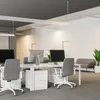Why leasing assets be the best practice followed by office occupiers post COVID-19
Post COVID-19, most corporates are looking to weave in more flexibility and remote work options and a palpable shift towards the concept of leasing spaces.
The COVID-19 pandemic has radically changed how and where business gets done. The success of an office project to make it serve as a communal space that can foster innovation, boost productivity, and promote collaboration is largely dependent on meticulous planning, allocation, and deployment of capital.
Organisations will mainly assess the challenges and benefits of work styles before making transformative workplace decisions. By 2040, the real estate market is predicted to grow to Rs 65,000 crore ($ 9.30 billion) from Rs 12,000 crore ($ 1.72 billion) in 2019.
As per the IRE report, the office market in the top eight cities recorded transactions of 22.2 million square feet from July 2020 to December 2020, whereas new completions were recorded at 17.2 million square feet in the same period.
In terms of share of sectoral occupiers, the IT and ITeS sector dominated with a 41 percent share in the second half of 2020, followed by BSFI and manufacturing sectors with 16 percent each, while other services and co-working sectors recorded 17 percent and 10 percent, respectively.
India remains a preferred global outsourcing destination, and going forward, the evolution of a ‘traditional’ to ‘hybrid’ workforce via work-from-anywhere model to ensure business continuity plan and hub-and-spoke models may come into play selectively.
Organisations will re-evaluate their strategy and focus on higher flexibility and innovative solutions models, such as reverse office, fit-outs as a service, dry and wet leasing, and pay per use, among others.
The emerging concept of reverse office
With the COVID-19 outbreak, the real estate market witnessed a dip in the demand with an almost three-month lockdown, creating uncertainty in businesses.
The unprecedented disruption and revenue loss inflicted by a never-before-seen situation forced many organisations across the globe to rethink their workspace requirements and the costs incurred in non-core business activities.
'Reverse office' model offers a unique solution to businesses who are looking for downsizing or can maximise their returns on the existing lease by surrendering their entire portfolio and signing a new lease, which gives them the freedom and flexibility to twist their conventional lease and shift to a managed office lease.
This way, the enterprise gets to retain the office space they need from the entire area, and the remaining space could be subleased to other enterprises.
Additionally, through this service, enterprises save anywhere between 20 percent and 50 percent of maintenance and administration costs based on surrendered area and optimised rentals while enjoying the flexibility to scale up and take smaller portions of real estate within the same vicinity as and when required.
Fit-out as a service
Fit-out as a service is a unique concept to service the office fit-out requirement without any capital investment, capex converted to opex, yet, the entire design and execution as per client’s specifications.
Whether it’s a low-cost investment or a high-end interior, all a client has to pay is a fixed rental for the term of the lease.
Additionally, flexible rental options are offered to the companies that allows numerous benefits, including tax benefits. Leasing office fit-out offers lucrative tax benefits as payments are 100 percent tax-deductible.
No large upfront cost means capital is retained with the business, maintaining working capital that can be invested into other revenue-generating operations.
Fit-out as a service can allow companies to save anywhere between 15 percent and 20 percent over traditional capex.
Asset management services
There are several aspects to running a functional office space, and managing assets can be one of the alarming costs and headaches as seen by the CFOs and CREs.
One of the important options available to the client is the sale and leaseback of their existing assets and additionally provide an option to buy furniture, fixtures, fit-out, servers, and other IT assets, allowing cash injection and leasing them back, allowing tax savings on the rentals paid.
Thus, the balance sheet would become lighter, financial ratios would improve, and companies can invest the cash in core business rather than staying invested in depreciating assets.
Pay-per-use
The pay-per-use business model is when the client is charged for specific usage of a product or service. Overall, this model is used for a short-term goal, making it often practical and affordable with no upfront capital expenditures or other spending.
Outlook
Post COVID-19, as with most other components of the work environment, the traditional parameters of a client’s budget and requirements are also witnessing a change.
Most corporates are now looking to weave in more flexibility and remote work options, resulting in heavier investment in technology for collaboration and video conferencing and a palpable shift towards the concept of leasing spaces.
Therefore, we expect that next-generation furniture such as flexible tables and desks and meeting room furniture would see greater traction, while demand for old-school workstations might get tweaked.
Corporates are also likely to realign their investment in fixed real estate assets, therefore, it is estimated that substantial growth in the use of leasing assets will emerge as a demand in the future.
Edited by Suman Singh
(Disclaimer: The views and opinions expressed in this article are those of the author and do not necessarily reflect the views of YourStory.)








